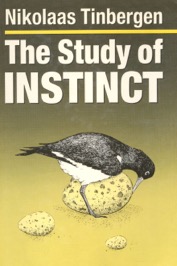 $2.99 on Kindle, Nook, Apple Books, Kobo, Google Play
$2.99 on Kindle, Nook, Apple Books, Kobo, Google PlayThe Study of Instinct by Nikolaas Tinbergen (83,000 words, 130 figures)
First published in 1951, The Study of Instinct is widely considered the foundational text of ethology, the study of natural behavior. Written to introduce the largely German literature of the early ethologists to an English-speaking audience, Tinbergen first describes the objectives, scope, and limitations of ethology, then goes on to describe the influence of external stimuli and internal factors on behavior, proposes his famous hierarchical-motivational model for the control of behavior, and ends with accounts of the development, adaptiveness, and evolution of behavior, including human behavior. The volume remains a classic and is often cited in the opening sentence of modern papers on behavior.
“... all in all, I think most students will learn more from the seemingly timeless Study of Instinct than from this or any other retrospective.” – Gould 1992, Science
“A few parts of the book still strike one as modern. The opening chapter, in which Tinbergen formulates his famous ‘four questions’ about animal behaviour (questions about mechanism, development, adaptiveness and evolution), and discusses the extent to which they are logically separate yet practically interrelated, should be read by every student taking a course in ethology. The section entitled ‘Learning Processes’ is a small masterpiece, prefiguring the ‘constraints on learning’ debate by 20 years and describing Tinbergen’s own classic work on learning in herring gulls and digger wasps... The Study of Instinct still has important general messages for anyone studying ethology; it will always be a significant book for historians of science; and it gives a first-hand account of some of the most important research that has been done on animal behaviour.” – Roper 1989, Trends in Ecology & Evolution
“Tinbergen’s book is a positive requirement for all students of behavior. It is most refreshing and stimulating account of some of the important contributions European scholars have been making to the study of instincts, a field of behavior sorely neglected in American psychology today... There is no question but that Tinbergen’s book is an important contribution to the study of behavior.” – Steller 1976, The Quarterly Review of Biology
“A well-reasoned and thoroughly readable book which points up the complexity of even the simplest unlearned behavior.” – Thomson 1952, Scientific American
“Dr Tinbergen’s book is an admirably clear, authoritative and factual account of recent work on animal instinct which can be strongly recommended to students of biology, both elementary and advanced, as giving a first hand account of the main trends of modern field research into animal behaviour.” – Thorpe 1954, British Journal for the Philosophy of Science
“American psychology has concentrated more and more during this century on the behavior of mammals, and even among mammals has restricted itself mostly to primates (man, chimpanzee, macaque) and a cheap primate substitute, the rat (which is not studied for its rattiness, so to speak, but as a bearer of anxiety and a maker of cognitive maps)... The importance of Tinbergen’s book is that it presents systematically a large amount of significant work by the European school of biologists, making it accessible to the English-speaking reader. The dominance of learning theory in America, established by Thorndike, Holt, and Watson, makes us persistently forget the constitutional factor in behavior (that is, instinct), and this book may help bring it to the graduate student’s attention even if his instructors are by now too set in their ways to give it the attention it deserves... The style is somewhat academic, but the book is full of fascinating, and solidly authenticated, observations of animal behavior. It should be read by everyone, psychologist or zoologist, who is interested in mechanisms of response.” – Hebb 1952, Journal of Abnormal and Social Psychology
“[This volume] summarizes much ingenious experimental work and present a point of view that is bound to have an influence on later behavior studies.” – Carmichael 1952, Science
“[This] is an important book and one that should be read by all students of animal behavior... The ingenious experiments and theoretical discussions will afford many hours of stimulating reading.” – Aronson 1953, Copeia
“... a scholarly and well-documented review of the general field [of ethology]... This books performs a beautiful job of pulling together diverse and diverging observations, experiments and concepts, suggesting theories that will surely lead to much new and fruitful work.” – Bates 1953, American Anthropologist
“Tinbergen’s fine book is an important synthesis and a valuable introduction to this actively moving field.” – Greenberg 1952, Physiological Zoology
“The final impression one gets from Tinbergen’s book is that of the immense richness and incredible variety of behavioral phenomena which are there for the studying if we break out of our rat-monkey-man triangle.” – O’Kelly 1952, Psychological Bulletin
“It is a pleasure to describe and discuss Tinbergen’s work. Well written, with elegant development of ideas and arguments, courageous in challenging faulty views and procedures, calm and confident in style, yet stimulating, the book should be read by anyone interested in the behavior of birds.” – Pitelka 1953, The Condor



